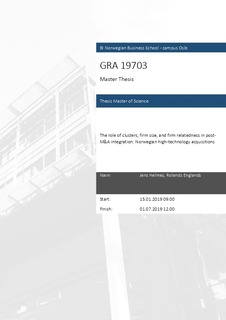| dc.contributor.author | Helmes, Jens | |
| dc.contributor.author | Englands, Rolands | |
| dc.date.accessioned | 2019-10-28T09:44:16Z | |
| dc.date.available | 2019-10-28T09:44:16Z | |
| dc.date.issued | 2019 | |
| dc.identifier.uri | http://hdl.handle.net/11250/2624820 | |
| dc.description | Masteroppgave(MSc) in Master of Science in Business, Strategy - Handelshøyskolen BI, 2019 | nb_NO |
| dc.description.abstract | Based on 92 acquisitions in the Norwegian high-technology industry, this
study analyzes the degree to which these targets were integrated into the acquiring
firm. By connecting post-acquisition integration theory with business cluster
research, we suggest that relative firm size, firm relatedness, and target firm’s
cluster affiliation affect the degree of integration of acquired targets. In addition,
the findings indicate that there is a moderating effect of cluster affiliation on the
size-integration relationship. We contribute with theoretical advancement, as well
as with a new methodological approach and relevant managerial implications that
serve as better support in post-acquisition integration decision making. Ordinal
logistic regression was used to analyze the Norwegian sample over a period from
2006 to 2015 with a minimum deal value of 10 million Euro.
Keywords
M&A; mergers and acquisitions (M&As); clusters; agglomeration; postacquisition
integration; post-merger integration; strategic management; acquiring
firms; corporate acquisitions; organizational change; integration; similarity;
complementarity; autonomy; ordinal logistic regression | nb_NO |
| dc.language.iso | eng | nb_NO |
| dc.publisher | Handelshøyskolen BI | nb_NO |
| dc.subject | strategy | nb_NO |
| dc.subject | strategi | nb_NO |
| dc.title | The role of clusters, firm size, and firm relatedness in post- M&A integration: Norwegian high-technology acquisitions | nb_NO |
| dc.type | Master thesis | nb_NO |

